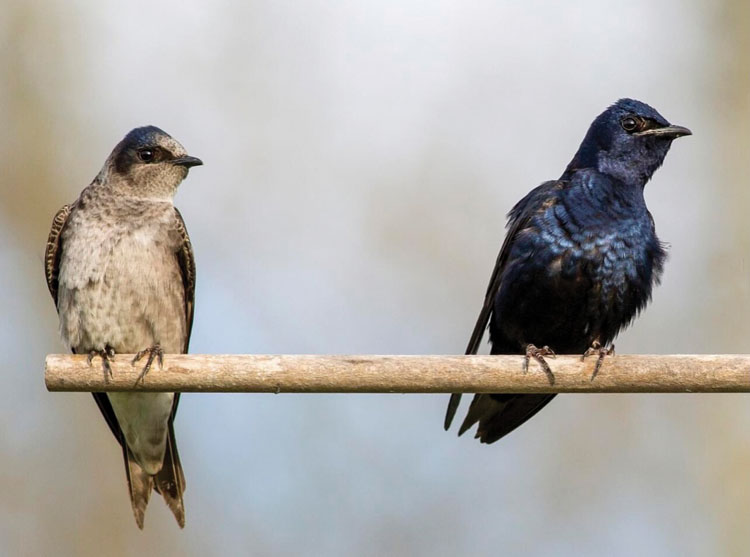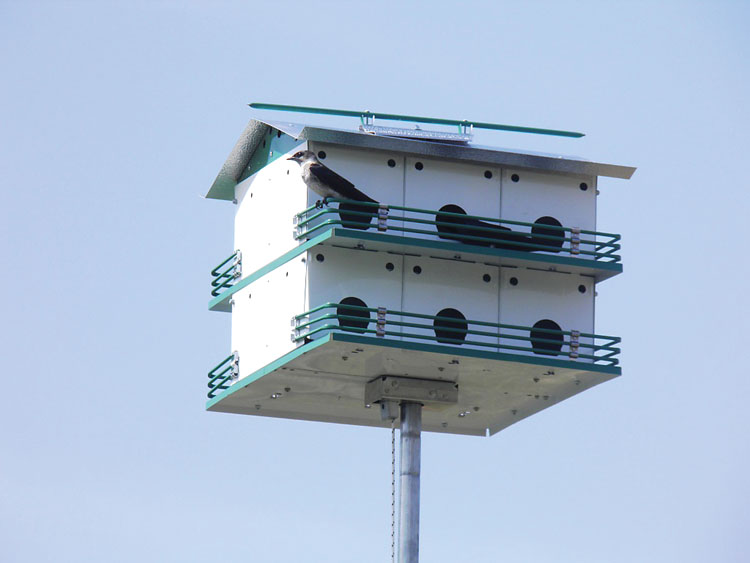Purple Martins in Florida
March 21, 2024 at 1:20 p.m.
 Female and male Purple martin.
Female and male Purple martin.
Purple martins (Progne subis) are the largest species of swallows that breed in North America. In the birding world, few species generate more excitement than the Purple Martin as they are now making their arrival throughout Florida.
The earliest arrivals to the eastern United States occur in the state of Florida beginning in late January and conclude in late June. These dates and locations are carefully monitored by martin enthusiasts nationwide. The purple martin is not only North America’s largest sized swallow, but it is also a beautiful songbird.
Purple martins are beneficial birds to have near a home or on a property because they eat insects. These birds feed during daylight, and their diet consists mainly of beetles, moths, dragonflies, butterflies, horseflies, and leafhoppers. They will also eat mosquitoes, but mosquitoes only make up less than 1 percent of their diet. One of the greatest benefits that can be garnered by providing housing for Purple Martins is the birds reduce the general bugginess around human habitation. Another one is that the martins protect barnyard fowl by mobbing and chasing hawks.
While generations of Americans have hosted purple martins, the custom was actually adopted from Native Americans who were the first to hang out nesting gourds. When indigenous peoples would hang out their gourds to dry, Purple Martins started nesting inside them. The gourds were then decidedly left hanging up in their villages for the birds to live in. To this day, Purple Martins are one of the only bird species to prefer human-made houses over natural ones.
Historically, Purple Martins have resided in wetland habitats and forest edges. Some purple martins in the eastern United States have been known to nest in holes in buildings or cliffs as tree habitat is limited and competition is fierce from other birds. This famed swallow is now dependent on man-made housing and faithfully returns to the same locations each year. Understandably, human “landlords” anxiously await the return of “their” birds from wintering grounds in South America. As a result of man-made bird house structures, Purple Martins are able to breed in a much larger geographic range.
Purple Martins seem to prefer to nest near human habitats rather than in the rock crevices and tree cavities in which they nest in the wild. Purple Martins are a bird species that has maintained a commensal association with humans for centuries. In the 19th century, most of these birds used to nest in abandoned Woodpecker holes, but now they nest almost exclusively in bird houses. Purple Martins are birds of the open sky, catching insects on the fly.
Although these birds are quite large, they are not able to compete with other birds for nesting sites. Purple Martins are not nearly as aggressive as House Sparrows and European Starlings. If it came down to it, these two species of birds would kill adult purple martins to acquire nesting sites. If human interference was absent, these birds would make it extremely difficult for Purple Martins to survive by altering nest cavities.
Purple Martin houses better protect nestlings from both inclement weather and predators. The specially shaped entrance holes are designed to admit martins while restricting European starlings, an invasive, non-native species. Purple Martins typically return to their breeding sites as long as they are suitable. If significant changes are made to their breeding sites, Purple Martins will search for new ones.
 Purple martin bird house.
Purple martin bird house.
The Venice Area Audubon Society offers training to local residents in hopes the 24 gourd racks, that are strategically hung and fortified with pine needles inside of each gourd, will entice Martins to begin nesting. Purple Martin teams check the nesting boxes and gourds at the Venice Rookery site at 4006 Tamiami Trail South, Venice, every five days throughout the season in order to band, record nests, eggs laid, eggs hatched, nestlings and fledged birds. The goal is to establish a thriving Purple Martin community to observe and enjoy. One of the best ways to help increase our local Purple Martin population is to establish and manage artificial nesting cavities as adult Martins are extremely faithful to colonies, returning year after year.
The Purple Martins’ breeding range is throughout temperate North America. As these birds are mostly dependent on insects, there are only a couple of areas where Purple Martins migrate to in California generally around Sacramento near Napa Valley and further up Northern California along the border to Oregon. Single birds or small flocks may be seen flying around potential nest sites. These early Martin arrivals are often referred to as scouts. They usually disappear for a few days and return with their mates. However, the term “scout” is really a misnomer. The early Martin arrivals are simply experienced mature Purple Martins that have made the journey before and are eager to reclaim their housing. Young Purple Martins rarely return to their old nesting sites.
The first wave of migrants is often paired on arrival. First-year birds, often referred to as sub-adults, seem to arrive without mates. Many of those arriving later may not be paired. Surveys indicate that the species has been returning in slightly fewer numbers throughout Florida. This may be due in part to the decline in the waning tradition of erecting housing. Purple Martins certainly appear to prefer nesting near human habitats rather than the places in which they nest in the wild and Martins are still fairly common in places where housing is maintained.
While some martins breed on the East coast of North America, others have been found to “island hop” or leave from the Yucatan and touch down in the eastern areas of Florida. Those that island hop have been observed leaving their winter home in Brazil and making their way into western Venezuela. From Venezuela, they then cross the Caribbean in flight to Cuba and other islands. Eventually, they arrive in North America through Florida completing an approximate 5,000-mile journey.
Spring migration is notably much quicker than the fall for Purple Martins and is supported by the theory that the Martins will labor to be the first bird back to their breeding grounds in order to secure the best cavities, locations, and mates. The migration routes that individual martins take will vary from year to year and even within the same breeding season. Unpaired Purple Martins are always on the lookout for potential breeding territories. If suitable sites are not found, they will frequently challenge territory holders.
Most of these battles are won by territory holders, but some challengers are persistent in their efforts and successfully drive the territory holders away. Adult males protect their territories from other males, and females do attack other females. These encounters are usually repetitive and violent, often causing severe injury to the involved parties. Unfavorable weather conditions are also hazardous to Purple Martin populations. In many instances, northern populations have been completely wiped out due to bad weather conditions. Purple Martins are also vulnerable to aerial predators such as hawks and owls, and ground predators such as raccoons, snakes, and squirrels. It is a known characteristic of Purple Martins to protect themselves.
Since this species has become extremely popular visitors to human-made bird houses, their breeding habits have changed significantly. Several instances of Purple Martin pairs competing for egg incubation have been observed. Females primarily incubate the eggs, but males do assume this position in the absence of females. When the female returns, she finds it very difficult to displace the male from his position. In this case, she has to get below the male and drive him away.
After hatching, the young remain in the nest for 24 to 28 days and are fed insects by both adults. Young martins may continue to roost in the nest at night after they are able to fly. After fledging, juvenile Purple Martins, as well as adults and sub-adults will congregate at a roost. Large flocks of martins gather to spend the night at these roosts, which are usually situated near water or in trees.
Founded in 1987, the Purple Martin Conservation Association was established to aid the species, and is the primary leader in research, education and conservation efforts of Purple Martins. Resources including ideal nesting materials for establishing your own Martin colony can be found on their website; purplemartin.org. Annual mortality rates are 50 percent for adult Purple Martins and 60 to 70 percent for juveniles. On average Purple Martins only live one to two years. Although, the oldest Purple Martin on record lived to be 13 years, 9 months old. Reported data indicates that it had been banded in 1933 and spotted again in the state of Illinois where it was originally banded in 1947.
As wonderful as these birds are to see, the species has dramatically declined 56% since 1988. We can help Purple Martins and other native species thrive by planting native habitats and reducing pesticide use. A minimal investment of around $200 can provide anyone who is interested an opportunity to host these precious passerines and become a Purple Martin landlord with the most ideal habitat.